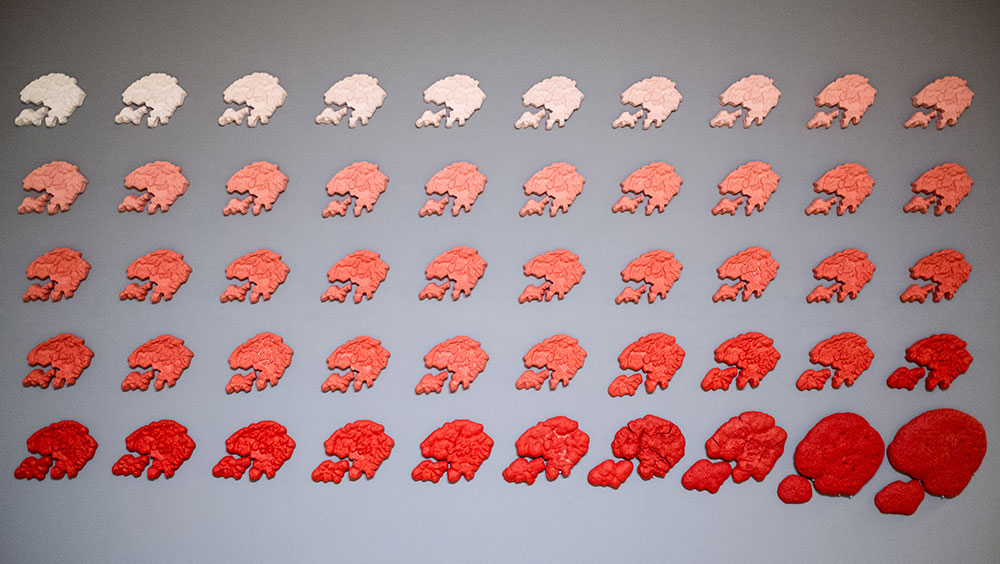
Ho Lai, Fluxing Red, 2021. Photo: Jenny Harper.
Various venues, Stoke-on-Trent
11 September – 17 October 2021
by VERONICA SIMPSON
There is always a frisson of discovery or the unexpected about the British Ceramics Biennial, and 2021’s event is no exception. For starters, the cathedral-like China Hall at the disused Spode factory was – at very short notice - declared not safe for the public and so these fragile exhibits were arranged in an infinitely more cramped, bunker-like space: the double basement below Stoke’s Goods Yard; this unlovely canal-side warehouse is currently used by the local council for spillover office space and storage.
To host this year’s ceramic treasures, the bureaucratic flotsam and jetsam of decades have been whisked away, and the interiors spruced up: utilitarian nylon office carpets are now spotlessly clean, the 1980s wallpaper has been lavishly coated with white emulsion, and those classic, texture-leeching bright 80s office lights dusted down and relit. It isn’t the most prepossessing space in which to view delicate items made from one of the most fragile and tricksy artist materials imaginable. But, somehow, it still works.
If there is one advantage to this new venue, it is that the rabbit warren of cellular spaces over two floors lends itself rather well to displays by individual artists, whose work can, in the vastness of the open-plan China Hall, lose impact when vying for attention against such a rich ceramic smörgåsbord.
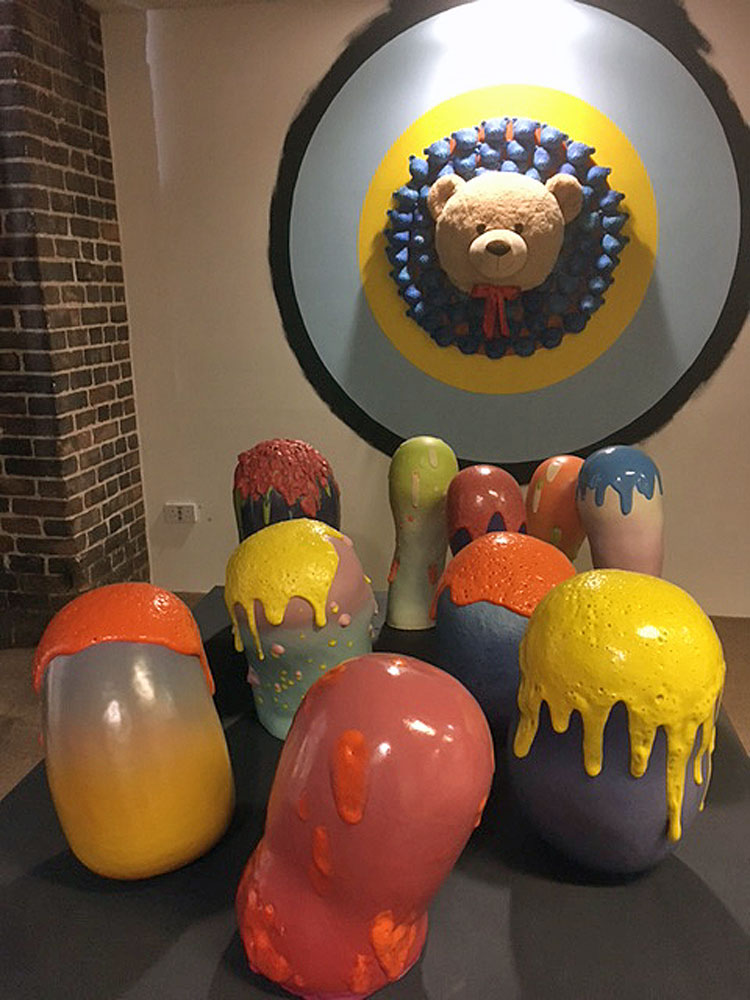
Pam Su. Lost and Found, 2021. Photo: Veronica Simpson.
One work that really shines in its dingy, office cave is Pam Su’s immersive installation Lost and Found (2021), featuring a giant teddy bear’s head mounted on a target board, in front of an assortment of lusciously glazed, brightly coloured totems. Su, the caption tells us, “channels the vast, wild and lonely psyche of the American west and pulls contemporary ceramics practice along for the ride”. Indeed, Su is one of several artists featured in the Awarded Fresh Talent section, a vital element of the biennial’s education and artist support programme, offering a two-year residency to artists who have exhibited in the Fresh graduate show at the previous biennial. The idea is to encourage experimentation and fast-track their evolution.
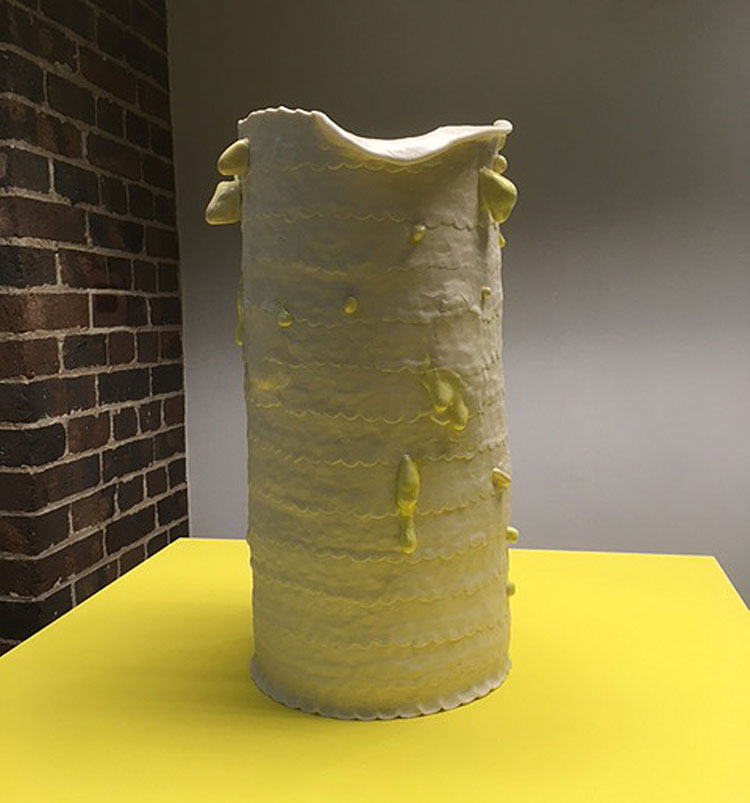
Toni de Jesus. Photo: Veronica Simpson.
Although for this year’s mentees, most of the tuition and encouragement were delivered virtually, the results are still impressive. Toni de Jesus’s vessels, dribbling daubs of treacly black or bright yellow pigment, are clearly a departure from his usual muted and spectral works. Likewise, Stoke native Laura Plant’s deliciously perky pigeons, atop her immaculate and classical Spode-style vessels, successfully conjure “Stoke’s past, present and future”, as she claims, evoking the legacy of Spode craftsmanship and prestige as well as the Spode campus’s current state of dereliction. According to Clare Wood, the new biennial director, Plant so enjoyed her residency experience, she felt as if her practice “had accelerated 10 years in just two”.
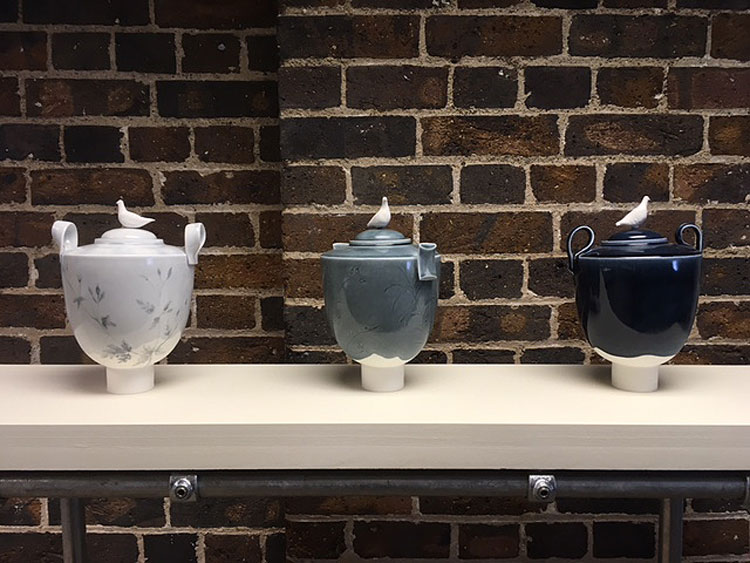
Laura Plant. Photo: Veronica Simpson.
Despite the challenges of the last year and a half – especially the largely online teaching and lack of studio access - the Fresh presentation this year is every bit as inspiring as before, and perhaps more so given that the qualifying requirement to have graduated recently from an official ceramic or fine art course has been expanded to include self-taught and emerging artists of all ages and backgrounds.
.jpg)
Elizabeth Jackson. Very interesting thoughts to think, 2021. Photo: Veronica Simpson.
I loved the curly quirkiness of Elizabeth Jackson’s assembled figures in her presentation: Very Interesting Thoughts to Think (2021). Janet Lines’s work was remarkable – beautiful, blowsy and voluptuous vessels, the rippling contours of which must be so hard to achieve at such scale. Having begun her art career in 1975, Lines waited 45 years to take her ceramic practice to the next stage, completing her MA in ceramics at Farnham in 2020.
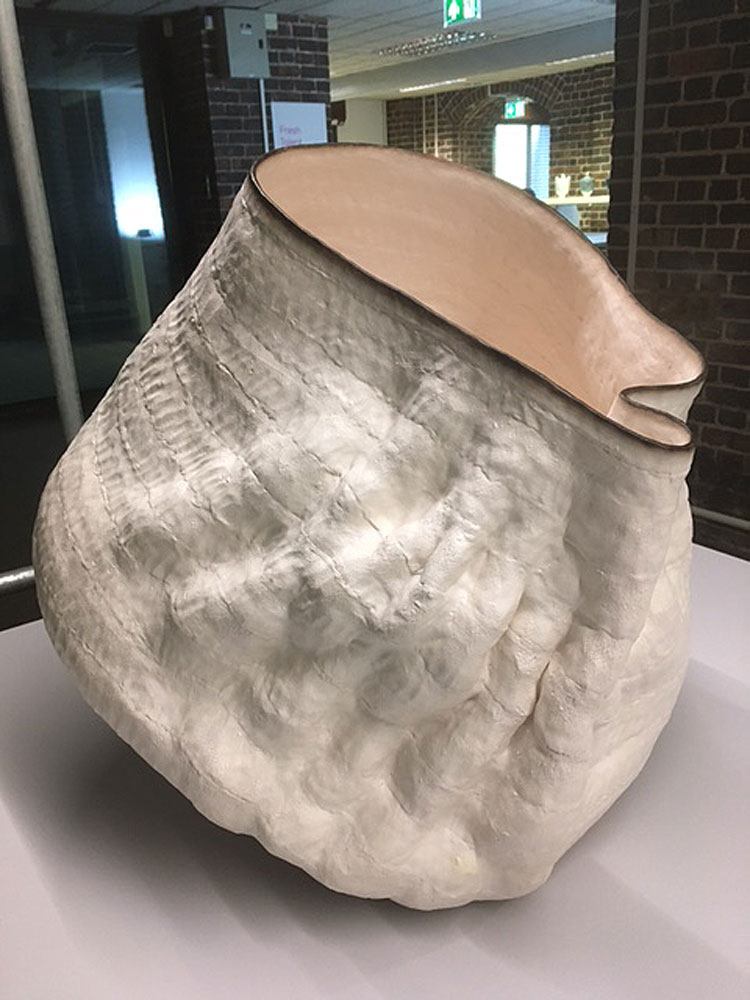
Janet Lines. Photo: Veronica Simpson.
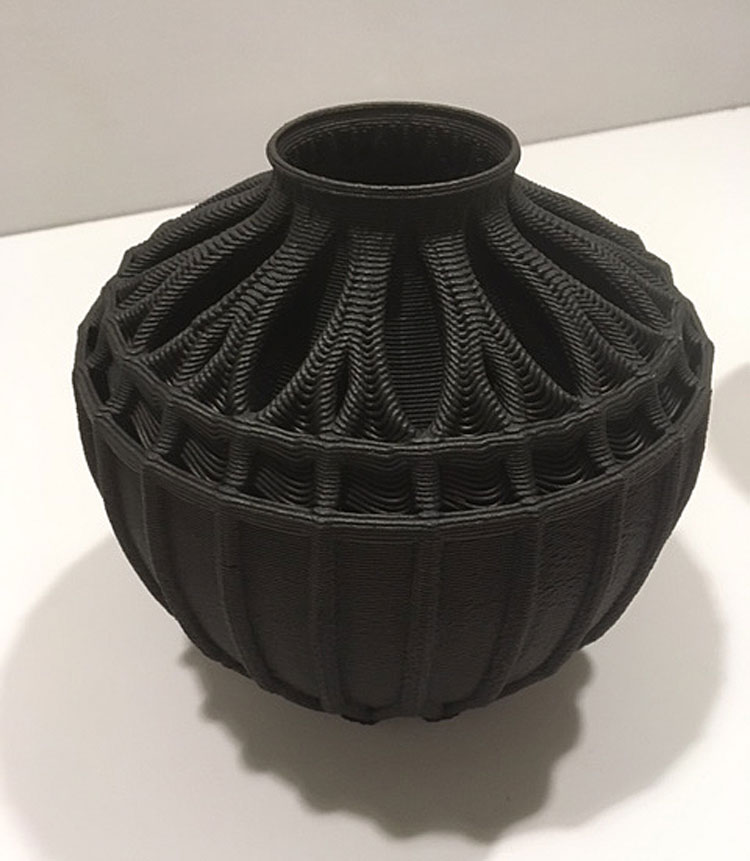
Nico Conti. Anecdote of Home and Porcelain. Photo: Veronica Simpson.
The Maltese-born Nico Conti presented Anecdote of Home and Porcelain: beautiful, digitally printed ceramic vessels, in black and white, with their wonderful textures and forms evoking inspirations from his childhood, such as Maltese lace, vaulted cathedrals and sea urchins, helped to shift my reluctance to accept that 3D printing does have something to offer contemporary ceramics. The trick, he explains, is to “alter the uniformity of clay printing (to) push porcelain to unexplored territories”.
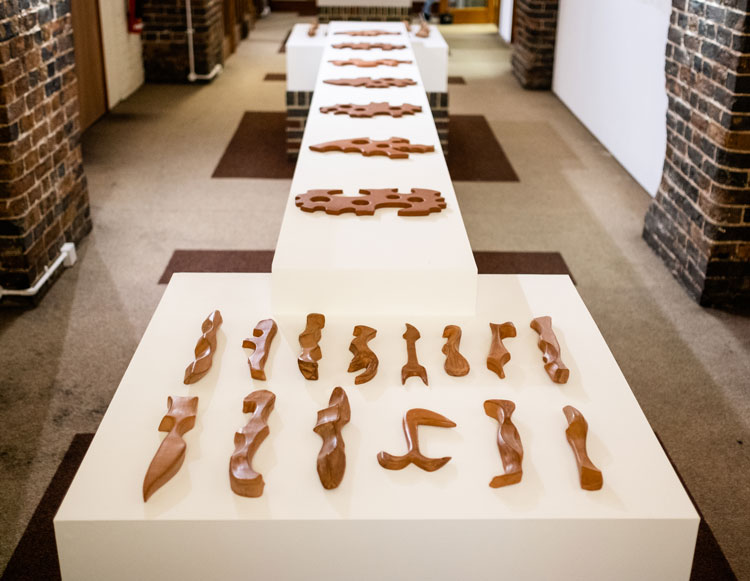
Tamsin van Essen. Photo: Veronica Simpson.
As ever, Award is a major highlight – a biennial staple, this strand pits 10 of the UK’s most exciting ceramicists (selected from hundreds of contenders) to compete for a £5,000 cash prize. Having long been a fan of Tamsin van Essen’s work exploring disease (her Psoriasis vases are stunning, trust me), it was intriguing to see her pieces inspired by ancient tools, including African throwing knives and Ayurvedic medical diagnostic instruments, The Residue of Tools (2021). Ho Lai’s Fluxing Red (2021) really stood out – literally and symbolically. This Hong Kong-born artist created 50 bone china relief maps of her home islands, which are arranged in rows, gradually transitioning from pristine white through soft and luscious pinks to the bloodiest red. The work references Hong Kong’s transition from British to Chinese rule, and though she says interpretation is “open”, there are obvious conclusions to be drawn, as the crisp detailing of the last few maps appears to dissolve into a more amorphous, spongy mass, losing all its distinctive features.
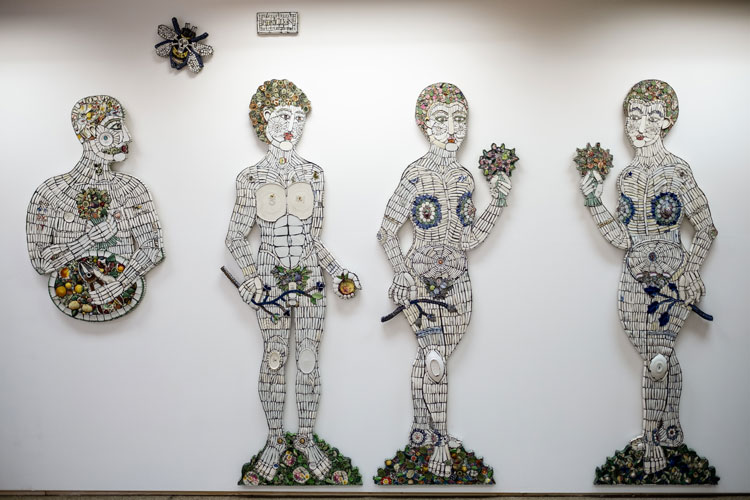
Cleo Mussi. Detail from Phylum, Phlon, Phylogeny, Phyllon and Phyllosilicates, Taxonomu, Race, Origin, Leaf and Clay, 2021. Photo: Jenny Harper.
The British Ceramics Biennial provides an invaluable platform for artists unafraid of tackling big topics. Another Award artist, Cleo Mussi, uses recycled tableware to create life-sized mosaic figures that offer an evolutionary timeline of humanity. Mussi assembles her figures, titled Phylum, Phylon, Phylogeny, Phyllon and Phyllosilicates. Taxonomy, Race, Origin, Leaf and Clay (2021), using ceramic fragments and scraps she trawls from the streets and skips. These life-sized constructions, which reference religion, folklore, medicine, herbalism, fake news and finally a “non-binary” ceramic spaceperson, typically take six weeks to complete.
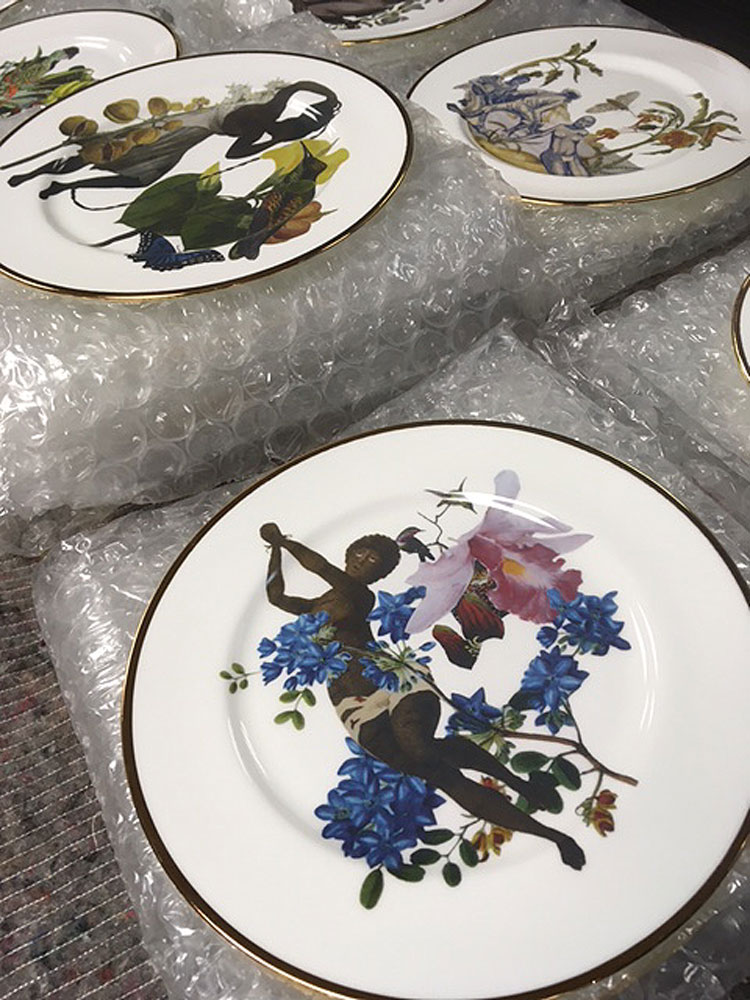
Jaqueline Bishop. History at the Dinner Table, 2021. Photo: Veronica Simpson.
Politically charged topics can translate powerfully into pottery, as is evident in the decorated plates of Jacqueline Bishop, a post-colonial interpretation of fine dining entitled History at the Dinner Table (2021). Bishop is a writer and artist and a professor at New York University, and this is the fruit of a collaboration with SET, an independent, artist-run collective based in London. Growing up in Jamaica, Bishop was puzzled by the scenes of English life depicted on her parents’ “only for best” bone china tableware, which was kept in a mahogany cabinet. With its fields, palaces and horse-drawn carriages, it presented an alien world to her. She has responded by collaging together her depictions of idyllic Caribbean life, rich in colour and vegetation, which have been hand painted on to 18 dishes. Though they were still emerging from their bubble wrap and box during the press tour, they will apparently be displayed in large, mahogany cabinets, just like those prized originals.
-part-of-Leach-100.jpg)
Amy Hughes. A Potter’s Book, 2021. Photo: Veronica Simpson.
Another highlight in the Goods Yard space is the Leach 100, a series of commissions celebrating 100 years of the pioneering St Ives pottery founded by Bernard Leach and Shoji Hamada. My favourite was artist Amy Hughes’ A Potter’s Book (2021), a response to Leach’s tireless investigations into brushwork. She fashioned her own brushes from an eclectic range of materials foraged from around the original pottery in St Ives, including sandpaper, rubber bands, feathers, cable ties and chip forks. The resulting strokes and patterns created on her large, luminous vessels, are wonderfully haptic.
As ever, there are plenty of things happening elsewhere around this still far-from regenerated city. A must-see (though it was still being installed when I visited) will be Neil Brownsword’s examination of failure in the history of ceramic experimentation. This talented artist, curator and professor of ceramics at Staffordshire University always comes up with exciting perspectives, and this solo show, at the Potteries Museum and Art Gallery, called Alchemy and Metamorphosis (which runs until 30 January 2022), explores the transition from craft to industry from 1650 to 1800. He delves deep into the earliest known porcelain formulas, and Josiah Wedgwood’s early recipes for manufacture – recorded meticulously in Wedgwood’s notebooks, but in code to prevent industrial espionage. His choice of objects from the Museum Collection articulates important stages in the discipline’s evolution, and Brownsword also brings that experimentation bang up to date, with his own trials in digital ceramic printing: he found a way to make the computer program “glitch” to see what might happen, and will display some of his weird and wonderful warped designs.
AirSpace is a collaborative, artist-led gallery that has been at the forefront of Stoke’s ceramic and contemporary art programme since it launched in 2006. This year, for the biennial, it highlights the role of clay in everyday life as well as art, with a show called Use and Ornament. It all starts with a cup of tea: you can choose your own vessel from shelves full of Japanese-style everyday Yunomis – teacups – made by 14 of the current studio pottery apprentices on Stoke’s Clay College course (the cups are also offered for sale in the mini shop). You can brew up a herbal concoction of tea, made by the artist in residence at Spode’s Rose Garden (using herbs taken from that garden) and then browse the show. Up front are samples from, and a directory of, brickmaking techniques, the result of a collaboration with an old St Austell brick mine and one of its long-time brickmakers.
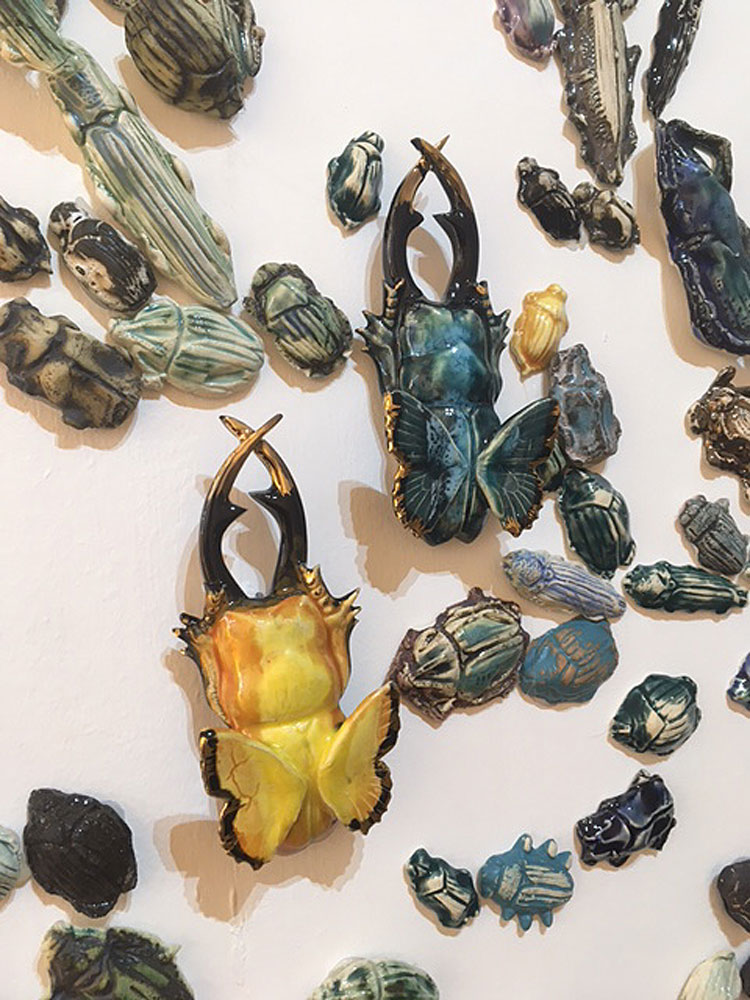
Anna Collette Hunt. Stirring the Swarm, 2021 (detail), Airpsace gallery. Photo: Veronica Simpson.
Further into the gallery, you meet the art, in the form of Anna Collette Hunt’s Stirring the Swarm (2021) installation – a multitude of handmade ceramic insects, fusing her entomological investigations (she studied the vast collection at Nottingham’s Natural History Museum at Wollaton Hall) with her imagination. The resulting glowing, minibeasts glide across the walls and up across the ceiling. There is also a poignant clay-based stop-motion animation about habitat loss, called Cheese Grows Blue (2021), accompanied by one of the delicate china sets from Katie Spragg.
For me, a real standout revelation of this year’s biennial was the Cumbria-based artist Paul Scott, who has been gently subverting the tradition of the printed plate for the last 30 years. Here, in a series titled Cumbrian Blue(s), he responds to traditional blue ware in a variety of ways: into its delicate engravings of pastoral scenery, he inserts elements of polluting industries such as smoking factory chimneys, or he makes multi-lane highways or car parks the subject, in that distinctive blue, or joins mismatched plate parts together while sealing the joins, kintsugi style, in gold leaf. He has inserted these disruptive elements, like a kind of treasure trail, into the cabinets filled with more orthodox bone china treasures, in the Spode Museum Trust and Heritage Centre.
There is not enough space or time here to detail the fruits of the rich array of year-round education and community engagement initiatives displayed around the show, but expect to find workshops and talks as well as pop-up exhibitions throughout the spaces, during the biennial’s five week duration.
Although Stoke has an obvious right to claim this rare festival of ceramics – as the former heart of British ceramic manufacturing – it always amazes me that there is nothing like this anywhere else in the world. Thanks to the expertise and networks of curators and teaching staff from Staffordshire University’s esteemed ceramics courses, the biennial always gives a global perspective – and this year features outstanding examples of work from master craftsmen of Japan’s Kasama potteries. Given its international scope and consistently world-class work, it’s strange that the biennial has such a low profile within the arts calendar. Woods is hoping to do something about that – and she has form: in a cultural regeneration role, she helped to fundraise and manage the expansion of the MK Gallery to put Milton Keynes on the cultural map.
It would seem an obvious move for Stoke to rebuild its contemporary identity and economy on the amazing creative and industrial legacy of its pottery past. Yet the regeneration that looked so likely on my first visit in 2013 – with a multitude of empty factory and workshop spaces waiting to be occupied by artists and creatives – is still far from visible. It is happening slowly – the Spode complex now features a decent warehouse conversion hotel, and permanent studio space; the Goods Yard will, allegedly, be transformed into a mixed-use hotel, apartment and leisure complex. But the feeling of potential is still latent rather than overt. It’s coming, says Wood. I hope she’s right.